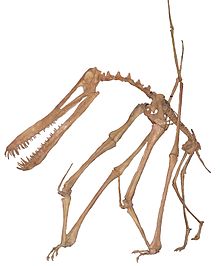Anhangueridae is a group of pterosaurs within the suborder Pterodactyloidea.[2] They were among the last pterosaurs to possess teeth. A recent study discussing the group considered the Anhangueridae to be typified by a premaxillary crest and a lateral expansion in the distal rostrum. The same study presented a cladistic analysis, for which an "agreement subtree" was calculated. The Anhangueridae was found to be sister taxon to the large crested Tropeognathus.[3]
| Anhanguerids Temporal range: Early-Late Cretaceous,
| |
|---|---|

| |
| Anhanguera santanae skeleton | |
| Scientific classification | |
| Domain: | Eukaryota |
| Kingdom: | Animalia |
| Phylum: | Chordata |
| Order: | †Pterosauria |
| Suborder: | †Pterodactyloidea |
| Clade: | †Anhangueria |
| Family: | †Anhangueridae Campos & Kellner 1985 |
| Type species | |
| †Anhanguera blittersdorffi Campos & Kellner, 1985
| |
| Subgroups | |
| |
Relationships
editThere are competing theories of ornithocheiromorph phylogeny (evolutionary relationships). Below is cladogram following a topology recovered by Brian Andres, using the most recent iteration of his data set.[4]
| Anhangueridae | |
The cladogram below follows Pêgas et al. (2019), who recovered Anhangueridae as a much more inclusive group. The analysis found most of the ornithocheirids falling into this family, while Ornithocheirus itself was recovered as a basal member of Ornithocheirae.[5]
The clagogram below is reproduced from Richards et al., (2023), who based their data matrix on the data matrix in Holgado and Pêgas, (2020). In the paper they erect the clade Mythungini which comprises all Australian tropeognathines.[6]
| Anhangueridae |
| ||||||
References
edit- ^ Renan A. M. Bantim; Antônio A. F. Saraiva; Gustavo R. Oliveira; Juliana M. Sayão (2014). "A new toothed pterosaur (Pterodactyloidea: Anhangueridae) from the Early Cretaceous Romualdo Formation, NE Brazil". Zootaxa. 3869 (3): 201–223. doi:10.11646/zootaxa.3869.3.1. PMID 25283914.
- ^ Campos, D. A. & Kellner, Alexander W. A. (1985). "Panorama of the flying reptiles study in Brazil and South America". Anais da Academia Brasileira de Ciências. 57: 453–466.
- ^ Rodrigues, Taissa & Kellner, Alexander W. A. (2013). "Taxonomic review of the Ornithocheirus complex (Pterosauria) from the Cretaceous of England". ZooKeys (308): 1–112. Bibcode:2013ZooK..308....1R. doi:10.3897/zookeys.308.5559. PMC 3689139. PMID 23794925.
- ^ Andres, B. (2021). "Phylogenetic systematics of Quetzalcoatlus Lawson 1975 (Pterodactyloidea: Azhdarchoidea)". Journal of Vertebrate Paleontology. 41: 203–217. Bibcode:2021JVPal..41S.203A. doi:10.1080/02724634.2020.1801703. S2CID 245078533.
- ^ Pêgas, Rodrigo V.; Holgado, Borja & Leal, Maria Eduarda C. (2019). "On Targaryendraco wiedenrothi gen. nov. (Pterodactyloidea, Pteranodontoidea, Lanceodontia) and recognition of a new cosmopolitan lineage of Cretaceous toothed pterodactyloids". Historical Biology. 33 (8): 1266–1280. Bibcode:2021HBio...33.1266P. doi:10.1080/08912963.2019.1690482. S2CID 209595986.
- ^ Richards, Timothy; Stumkat, Paul; Salisbury, Steven (6 October 2023). "A second specimen of the pterosaur Thapunngaka shawi from the Lower Cretaceous (upper Albian) Toolebuc Formation of North West Queensland, Australia". Cretaceous Research. 154. doi:10.1016/j.cretres.2023.105740.